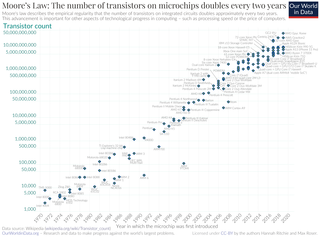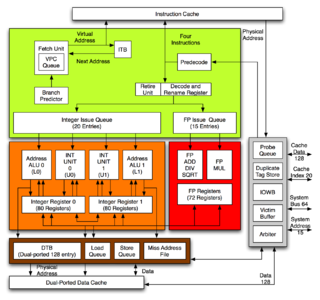
A field-programmable gate array (FPGA) is an integrated circuit designed to be configured by a customer or a designer after manufacturing – hence the term "field-programmable". The FPGA configuration is generally specified using a hardware description language (HDL), similar to that used for an application-specific integrated circuit (ASIC). Circuit diagrams were previously used to specify the configuration, but this is increasingly rare due to the advent of electronic design automation tools.

An integrated circuit or monolithic integrated circuit is a set of electronic circuits on one small flat piece of semiconductor material that is normally silicon. Large numbers of tiny MOSFETs integrate into a small chip. This results in circuits that are orders of magnitude smaller, faster, and less expensive than those constructed of discrete electronic components. The IC's mass production capability, reliability, and building-block approach to integrated circuit design has ensured the rapid adoption of standardized ICs in place of designs using discrete transistors. ICs are now used in virtually all electronic equipment and have revolutionized the world of electronics. Computers, mobile phones, and other digital home appliances are now inextricable parts of the structure of modern societies, made possible by the small size and low cost of ICs.

A microprocessor is a computer processor where the data processing logic and control is included on a single integrated circuit, or a small number of integrated circuits. The microprocessor is a multipurpose, clock-driven, register-based, digital integrated circuit that accepts binary data as input, processes it according to instructions stored in its memory, and provides results as output. Microprocessors contain both combinational logic and sequential digital logic. Microprocessors operate on numbers and symbols represented in the binary number system.
A programmable read-only memory (PROM) is a form of digital memory where the setting of each bit is locked by a fuse or antifuse. It is one type of read-only memory (ROM). The data in them are permanent and cannot be changed. PROMs are used in digital electronic devices to store permanent data, usually low level programs such as firmware or microcode. The key difference from a standard ROM is that the data is written into a ROM during manufacture, while with a PROM the data is programmed into them after manufacture. Thus, ROMs tend to be used only for large production runs with well-verified data, while PROMs are used to allow companies to test on a subset of the devices in an order before burning data into all of them.

A programmable logic device (PLD) is an electronic component used to build reconfigurable digital circuits. Unlike integrated circuits (IC) which consist of logic gates and have a fixed function, a PLD has an undefined function at the time of manufacture. Before the PLD can be used in a circuit it must be programmed (reconfigured) by using a specialized program.

An application-specific integrated circuit is an integrated circuit (IC) chip customized for a particular use, rather than intended for general-purpose use. For example, a chip designed to run in a digital voice recorder or a high-efficiency bitcoin miner is an ASIC. Application-specific standard product (ASSP) chips are intermediate between ASICs and industry standard integrated circuits like the 7400 series or the 4000 series. ASIC chips are typically fabricated using metal-oxide-semiconductor (MOS) technology, as MOS integrated circuit chips.

Programmable Array Logic (PAL) is a family of programmable logic device semiconductors used to implement logic functions in digital circuits introduced by Monolithic Memories, Inc. (MMI) in March 1978. MMI obtained a registered trademark on the term PAL for use in "Programmable Semiconductor Logic Circuits". The trademark is currently held by Lattice Semiconductor.

A complex programmable logic device (CPLD) is a programmable logic device with complexity between that of PALs and FPGAs, and architectural features of both. The main building block of the CPLD is a macrocell, which contains logic implementing disjunctive normal form expressions and more specialized logic operations.

The Generic Array Logic device was an innovation of the PAL and was invented by Lattice Semiconductor. The GAL was an improvement on the PAL because one device type was able to take the place of many PAL device types or could even have functionality not covered by the original range of PAL devices. Its primary benefit, however, was that it was erasable and re-programmable, making prototyping and design changes easier for engineers.

A multi-chip module (MCM) is generically an electronic assembly where multiple integrated circuits, semiconductor dies and/or other discrete components are integrated, usually onto a unifying substrate, so that in use it can be treated as if it were a larger IC. Other terms, such as "hybrid" or "hybrid integrated circuit", also refer to MCMs. The individual ICs that make up an MCM are known as chiplets. Intel and AMD are using MCMs to improve performance and reduce costs, as splitting a large monolithic IC into smaller chiplets allows for easy performance improvements, more ICs per wafer, and improved yield, as smaller dies have a reduced risk of getting destroyed by process variations during semiconductor fabrication. This approach also allows for chiplets to be reused in several products, reduces the amount of time required to design a module compared to designing a monolithic IC, and also reduces the number of bugs that have to be solved during design. However, communication between chiplets consumes more power and has higher latency than components in monolithic ICs. Each chiplet is physically smaller than a conventional monolithic IC die,. An example of MCMs in use for mainstream CPUs is AMD's Zen 2 design.

Integrated circuit design, or IC design, is a subset of electronics engineering, encompassing the particular logic and circuit design techniques required to design integrated circuits, or ICs. ICs consist of miniaturized electronic components built into an electrical network on a monolithic semiconductor substrate by photolithography.

The transistor count is the number of transistors in an electronic device. It typically refers to the number of MOSFETs on an integrated circuit (IC) chip, as all modern ICs use MOSFETs. It is the most common measure of IC complexity. The rate at which MOS transistor counts have increased generally follows Moore's law, which observed that the transistor count doubles approximately every two years.
Ze'ev Drori is an Israeli-born American technology entrepreneur currently residing in California. Drori was the founder and Chief Executive of Monolithic Memories, before the company merged with Advanced Micro Devices (AMD). He helped engineer the turnaround of struggling electric carmaker Tesla Motors as President and CEO from 2007 to 2008.

The Alpha 21264 is a Digital Equipment Corporation RISC microprocessor introduced in October, 1996. The 21264 implemented the Alpha instruction set architecture (ISA).
The following outline is provided as an overview of and topical guide to electronics:
Irwin Federman is an American businessman, philanthropist and General Partner of U.S. Venture Partners.
iCE is the brand name used for a family of low-power FPGAs produced by Lattice Semiconductor. Parts in the family are marketed with the "world's smallest FPGA" tagline, and are intended for use in portable and battery-powered devices, where they would be used to offload tasks from the device's main processor or SoC. By doing so, the main processor and its peripherals can enter a low-power state or be powered off entirely, potentially increasing battery life.












